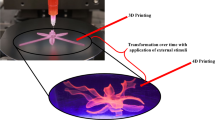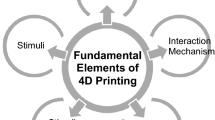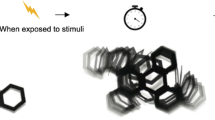Abstract
With the additional dimension, 4D printing is emerging as a novel technique to enable configuration switching in 3D printed items. In this paper, four major approaches, namely self-assembly of elements, deformation mismatch, bi-stability, and the Shape memory effect (SME), are identified as the generic approaches to achieve 4D printing. The main features of these approaches are briefly discussed. Utilizing these approaches either individually or in a combined manner, the potential of 4D printing to reshape product design is demonstrated by a few example applications.
Similar content being viewed by others
References
D. J. Richards et al., 3D Printing for Tissue Engineering, Israel Journal of Chemistry, 53 (9-10) (2013) 805–814.
R. Bogue, 3D printing: the dawn of a new era in manufacturing?, Assembly Automation, 33 (4) (2013) 307–311.
S. Bose, S. Vahabzadeh and A. Bandyopadhyay, Bone tissue engineering using 3D printing, Materials Today, 16 (12) (2013) 496–504.
S. Wilhelm and M. Curbach, Review of possible mineral materials and production techniques for a building material on the moon, Structural Concrete, 15 (3) (2014) 419–428.
W. E. Frazier, Metal Additive Manufacturing: A Review, Journal of Materials Engineering and Performance, 23 (6) (2014) 1917–1928.
O. Ivanova, C. Williams and T. Campbell, Additive manufacturing (AM) and nanotechnology: promises and challenges, Rapid Prototy** Journal, 19 (5) (2013) 353–364.
Y. Yamagishi et al., Three-Dimensional Assembly of Multilayered Tissues, in First Cirp Conference on Biomanufacturing, Rapid Prototy** J., (2013) 201–204.
Q. Ge, et al., Active origami by 4D printing, Smart Materials and Structures, 23 (9) (2014).
E. J. Pei, 4D printing -revolution or fad?, Assembly Automation, 34 (2) (2014) 123–127.
S. Tibbits, 4D printing: multi-material shape change, Architectural Design, 84 (1) (2014) 116–121.
S. Tibbits and K. Cheung, Programmable materials for architectural assembly and automation, Assembly Automation, 32 (3) (2012) 216–225.
W. G. Yang et al., Advanced Shape Memory Technology to Reshape Product Design, Manufacturing and Recycling, Polymers, 6 (8) (2014) 2287–2308.
Q. Ge, H. J. Qi and M. L. Dunn, Active materials by fourdimension printing, Applied Physics Letters, 103 (13) (2013).
L. Sun et al., Shape memory technology for active assembly/ disassembly: fundamentals, techniques and example applications, Assembly Automation, 34(1) (2014) 78–93.
W. M. Huang et al., Instability/collapse of polymeric materials and their structures in stimulus-induced shape/surface morphology switching, Materials & Design, 59 (2014) 176–192.
J. L. Zhang et al., Thermo-/chemo-responsive shape memory/ change effect in a hydrogel and its composites, Materials & Design, 53 (2014) 1077–1088.
H. Mallikarachchi and S. Pellegrino, Quasi-Static Folding and Deployment of Ultrathin Composite Tape-Spring Hinges, Journal of Spacecraft and Rockets, 48 (1) (2011) 187–198.
K. A. Seffen, Z. You and S. Pellegrino, Folding and deployment of curved tape springs, International Journal of Mechanical Sciences, 42 (10) (2000) 2055–2073.
K. A. Seffen, Hierarchical multi-stable shapes in mechanical memory metal, Scripta Materialia, 56 (5) (2007) 417–420.
W. N. Wu and Z. You, A solution for folding rigid tall shop** bags, Proceedings of the Royal Society a-Mathematical Physical and Engineering Sciences, 467 (2133) (2011) 2561–2574.
K. Krieger, Buckling down, Nature, 488 (7410) (2012) 146–147.
J. Kim et al., Thermally responsive rolling of thin gel strips with discrete variations in swelling, Soft Matter, 8 (8) (2012) 2375–2381.
X. Zhang et al., Optically-and Thermally-Responsive Programmable Materials Based on Carbon Nanotube-Hydrogel Polymer Composites, Nano Letters, 11 (8) (2011) 3239–3244.
L. Cao, A. Dolovich and W. J. Zhang, On understanding of design problem formulation for compliant mechanisms through topology optimization, Mechanical Sciences, 4 (2) (2013) 357–369.
G. R. Hayes, M. I. Frecker and J. H. Adair, Fabrication of compliant mechanisms on the mesoscale, Mechanical Sciences, 2 (1) (2011) 129–137.
L. Ionov, Actively-moving materials based on stimuliresponsive polymers, Journal of Materials Chemistry, 20 (17) (2010) 3382–3390.
L. Sun and W. M. Huang, Thermo/moisture responsive shape-memory polymer for possible surgery/operation inside living cells in future, Materials & Design, 31 (5) (2010) 2684–2689.
W. M. Huang et al., Sha** tissue with shape memory materials, Advanced Drug Delivery Reviews, 65 (4) (2013) 515–535.
H. Qin et al., Does Minimally-Invasive Pancreaticoduodenectomy Have Advantages over Its Open Method? A Meta-Analysis of Retrospective Studies, Plos. One, 9 (8) (2014).
F. Jelinek et al., Minimally invasive surgical instruments with an accessory channel capable of integrating fibre-optic cable for optical biopsy: A review of the state of the art, Proceedings of the Institution of Mechanical Engineers Part HJournal of Engineering in Medicine, 228 (8) (2014) 843–853.
M. Vaezi et al., Multiple material additive manufacturing–Part 1: a review: This review paper covers a decade of research on multiple material additive manufacturing technologies which can produce complex geometry parts with different materials, Virtual and Physical Prototy**, 8 (1) (2013) 19–50.
Y. Y. Hu and W. M. Huang, Elastic and elastic-plastic analysis of multilayer thin films: Closed-form solutions, Journal of Applied Physics, 96 (8) (2004) 4154–4160.
W. M. Huang et al., Micro NiTi-Si cantilever with three stable positions, Sensors and Actuators a-Physical, 114 (1) (2004) 118–122.
Y. Zhao et al., Buckling of poly(methyl methacrylate) in stimulus-responsive shape recovery, Applied Physics Letters, 99 (13) (2011) 131911.
C. C. Wang et al., Chemically induced morphing in polyurethane shape memory polymer micro fibers/springs, Reactive & Functional Polymers, 72 (2012) 757–764.
J. L. Zhang et al., Shape memory/change effect in a double network nanocomposite tough hydrogel, European Polymer Journal, 58 (2014) 41–51.
Q. Wang et al., Super-tough double-network hydrogels reinforced by covalently compositing with silica-nanoparticles, Soft Matter, 8 (22) (2012) 6048–6056.
W. M. Huang et al., Shape memory materials, Materials Today, 13 (7-8) (2010) 54–61.
J.-S. Kim et al., Fabrication of 3D soft morphing structure using shape memory alloy (SMA) wire/polymer skeleton composite, Journal of Mechanical Science and Technology, 27 (10) (2013) 3123–3129.
K. Otsuka and C. M. Wayman, Shape Memory Materials, Cambridge University Press: Cambridge (1998).
T. Manzoor, G. Shabbir and F. Khalid, Analytical technique for the two-dimensional stress wave model of memory alloy dampers, Journal of Mechanical Science and Technology, 26 (10) (2012) 3059–3066.
A. Lendlein, Sihape-memory Polymers, Springer-Verlag Berlin Heidelberg (2010).
L. Sun et al., Stimulus-responsive shape memory materials: a review, Materials and Design, 33 (2012) 577–640.
W. M. Huang et al., Thermo/chemo-responsive shape memory effect in polymers: a sketch of working mechanisms, fundamentals and optimization, Journal of Polymer Research, 19(9) (2012) 9952.
X. Wu et al., Mechanisms of the shape memory effect in polymeric materials, Polymers, 5 (4) (2013) 1169–1202.
L. Sun et al., Polymeric shape memory materials and actuators, Liquid Crystals, 41 (2013) 277–289.
W. M. Huang et al., Thermo-moisture responsive polyurethane shape-memory polymer and composites: a review, Journal of Materials Chemistry, 20 (17) (2010) 3367–3381.
H. Funakubo, Shape Memory Alloys, Gordon and Breach Science Publishers: New York (1987).
Y. S. Liu et al., Structural coloring of aluminum, Electrochemistry Communications, 13 (12) (2011) 1336–1339.
T. Khudiyev et al., Structural Coloring in Large Scale Core-Shell Nanowires, Nano Letters, 11 (11) (2011) 4661–4665.
Y. Zhao, W. M. Huang and Y. Q. Fu, Formation of micro/nano-scale wrinkling patterns atop shape memory polymers, Journal of Micromechanics and Microengineering, 21 (6) (2011) 067007.
Sung-Hoon, H., H. Jaeyeon and L. Heon, Replication of cicada wings nano-patterns by hot embossing and UV nanoimprinting, Nanotechnology, (38) (2009) 385303.
S. H. Hong, J. Hwang and H. Lee, Replication of cicada wing’s nano-patterns by hot embossing and UV nanoimprinting, Nanotechnology, 20 (38) (2009) 385303.
L. Ionov, Soft microorigami: self-folding polymer films, Soft Matter, 7 (15) (2011) 6786–6791.
J. D. Chiodo et al., Eco-design for active disassembly using smart materials, Proceedings of the Second International Conference on Shape Memory and Superelastic Technologies (1997) 269–274.
J. Chiodo and N. Jones, Smart materials use in active disassembly, Assembly Automation, 32(1) (2012) 8–24.
H. Purnawali et al., Poly(methyl methacrylate) for active disassembly, Smart Materials and Structures, 21 (7) (2012) 075006.
X. L. Wu, W. M. Huang and H. X. Tan, Characterization of shape recovery via cree** and shape memory effect in ether-vinyl acetate copolymer (EVA), Journal of Polymer Research, 20 (2013) 150.
Author information
Authors and Affiliations
Corresponding author
Additional information
Recommended by Associate Editor Ki-Hoon Shin
Ye Zhou is currently a Research Associate in Nanyang Technological University, Singapore. He has been working on topics relating to properties of shape memory polymers and their applications utilizing 3D printing methods.
Wei Min Huang is currently an Associate Professor in Nanyang Technological University, Singapore. He has over 20 years of experience on shape memory materials including alloys and polymers, and has published two books and over 100 journal papers in this field.
Rights and permissions
About this article
Cite this article
Zhou, Y., Huang, W.M., Kang, S.F. et al. From 3D to 4D printing: approaches and typical applications. J Mech Sci Technol 29, 4281–4288 (2015). https://doi.org/10.1007/s12206-015-0925-0
Received:
Revised:
Accepted:
Published:
Issue Date:
DOI: https://doi.org/10.1007/s12206-015-0925-0




